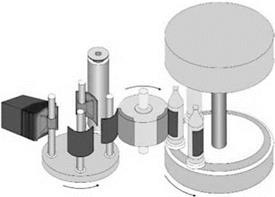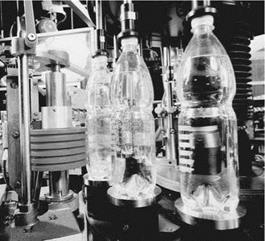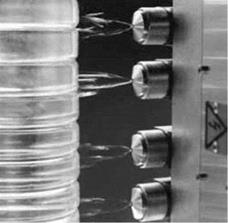As with precoated labels, adhesives used for so-called ‘inline’ labeling must be selected correctly to ensure high-quality labeling. For inline labeling, either waterborne adhesives or hot melts are applied during the labeling process — that is, at the same time as the labels. Both adhesive systems can be combined for special applications.
Waterborne Labeling Adhesives Labeling with waterborne adhesives has a long tradition. The first adhesives used for labeling were waterborne products based on natural polymers such as dextrin, starch or casein (one of the most ancient raw materials for adhesives [34]). Even today, casein-based adhesives are at the forefront of glass labeling, as they can be applied on wet and dry, cold and hot glass surfaces, and yield strong bonds. Furthermore, they have excellent running performance on labeling machines, even at the highest speeds (up to 80 000 bottles per hour or more).
However, as neither the availability nor the commodity price of casein is consistent, in recent years the development of new raw materials has made it possible to more closely approach the aim of developing synthetic adhesives with a machine running performance similar to that of casein-based adhesives. Labeling adhesives based on synthetic polymers have a high spreading capacity and initial adhesion (‘tack’) and, when compared to casein-based adhesives, savings of adhesive of up to 20% are possible when using them on dry glass bottles. They also have a less intense inherent smell and, owing to their very clean running properties, they prevent soiling of the labeling machines. Waterborne systems are usually applied by means of applicator drums and segments (Figure 8.34).
Whereas, casein-based adhesives are not suited for the labeling of plastic bottles, this does not apply to adhesives based on synthetic polymers (solutions or dispersions of synthetic resins) because their adhesion spectrum is much larger. Depending on the material of the containers, different types of adhesive are used. Special synthetic resins that are internally plasticized by copolymerization are particularly well suited for PE and PP containers. Colloid solutions of synthetic resin can also be used for polyethylene terephthalate (PET) and polycarbonate
|
Figure 8.34 A label applicator. |
containers. Waterborne adhesives allow both disposable and returnable containers to be reliably labeled.
Another interesting development that has taken place in the waterborne labeling adhesive sector in recent years has been the development of adhesives suited for film labels. Previously, waterborne adhesive use for film labels had failed due to the fact that neither the film nor the container material (e. g. glass or plastic) was able to absorb the moisture contained in the labeling adhesive, so that no reliable labeling was possible. However, newly developed systems allow the reliable labeling of film labels on nonabsorbent surfaces by means of waterborne adhesives. These have a high initial tack (i. e. they safely fix the labels) and are relatively fast setting, even in the case of nonabsorbent substrates. As they set into totally transparent films, they are also suited for ‘no label-look’ labeling. In addition, they can be used on existing labeling machinery designed for waterborne systems, and they have a good cost-performance ratio. Foil labels provide for high glossiness and resistance to water, and provide excellent clarity behind the label to see the bottle content.
Hot-Melt Labeling Adhesives Hot melts are 100% solids applied in the molten liquid state, either on the label or on the container, where they quickly cool to form durable bonds. Hot-melt labeling adhesives are based on synthetic thermoplastic rubber or EVA copolymers and resins, waxes and oils, with a mixing ratio tailored to the requirements of the desired application. Their open time (i. e. the time available for creating the bond) may be short or very long, as necessary. The hot melts are processed at temperatures between 120 °C and 170 °C, with a trend towards low processing temperatures, particularly for foil labels.
Hot melts have delivered particular performance in the ‘wraparound’ labeling of bottles and cans. Depending on the container material, different hot melts with different adhesion properties are available. These may be suited to the labeling of glass as well as of metal or plastic containers. One particular strength of hot melts is their excellent ‘pick-up’ function owing to a high initial adhesion and rapid bonding due to short curing periods. However, care must be taken that the temperature of the
|
Figure 8.35 A hot-melt applicator drum. |
container to be labeled is not too low, in order to prevent the hot melt from cooling and becoming solid too rapidly; hence, it is recommended that the surfaces of the containers are dried under control by using a fan. When wraparound labeling with hot melts, line speeds of up to 60 000 containers per hour can be achieved.
Both, paper and a wide variety of plastic foils are used as labeling materials. Transparent foil labels produced by reverse printing can be processed as accurately as can labels made from foamed plastic with insulating properties. For hot-melt labeling, the bottles coated with hot-melt adhesive draw the cut labels from a magazine stack (instead of a pallet dispenser coated with adhesive, as in the case of labeling with waterborne adhesives). The hot melts are applied either by means of applicator drums (Figure 8.35) or nozzles (Figure 8.36).
|
|
In the plastic bottle sector, returnable bottles (made from PET or polycarbonate) have become popular in recent years [35, 36]. As with disposable bottles, the adhesives are required not to interfere with the cleaning or recycling process, and consequently different hot melts have been developed for different recycling methods. Frequently, plastic bottles are washed prior to recycling, and any extrinsic material such as labels and adhesive must be removed in this process. Water-soluble or redispersable hot melts meet these requirements and provide for the clean recycling of plastic material.
In recent years, not only the formulation but also the handling of hot-melt adhesives has been improved; at present, granulated hot melts can be conveyed by automatic conveying systems. In the past, however, pressure-sensitive hot melts were packed in siliconized papers, although at present they are supplied in foil packages.
With this innovative packaging solution, hot melts need not be unpacked but simply placed into the melting container together with their package wrapping, thus providing easy processing and avoiding the disposal of package waste.
With ever-increasing demands as to the features of the containers, new processing technologies arise again and again. The introduction ofnew container materials and specifications by marketing and legal authorities has led to many innovations. Often, however, the desired results are beyond what properties of a single adhesive, and hence several adhesives must be combined. For example, tamper-evident seals that must not be water-soluble are bonded to bottle closures by means of hot melts, while waterborne adhesives are used for the labeling.
 1 декабря, 2015
1 декабря, 2015  Pokraskin
Pokraskin 


 Опубликовано в рубрике
Опубликовано в рубрике 